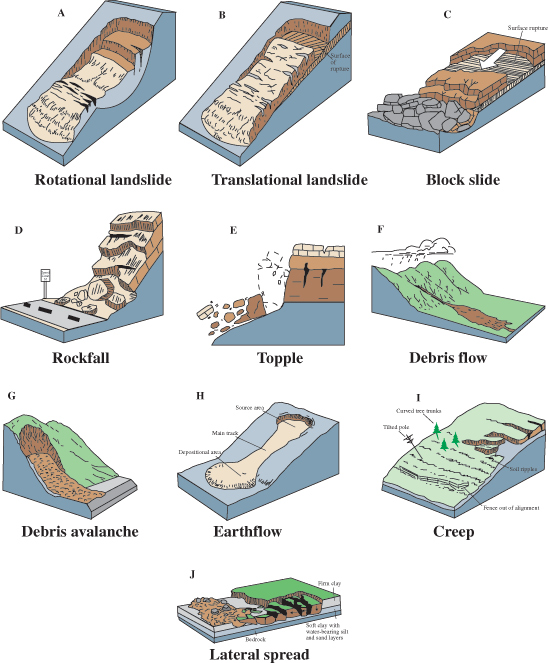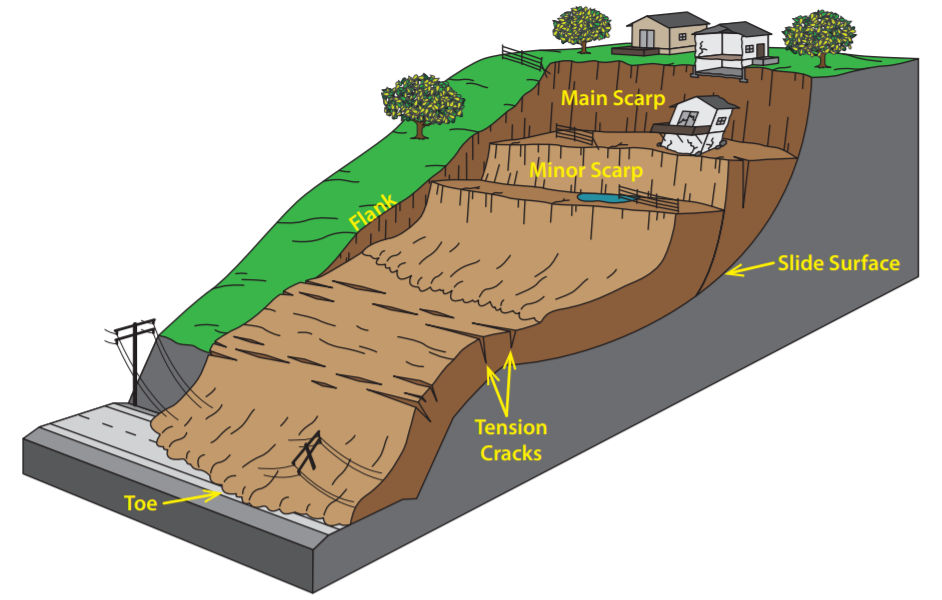10.3: Landslide Classification and Identification
- Page ID
- 6904
Mass-wasting events are classified by type of movement and type of material, and there are several ways to classify these events. The figure and table show the terms used. In addition, mass-wasting types often share common morphological features observed on the surface, such as the head scarp—commonly seen as crescent shapes on a cliff face; hummocky or uneven surfaces; accumulations of talus—loose rocky material falling from above; and toe of the slope, which covers existing surface material.
Types of Mass Wasting
The most common mass-wasting types are falls, rotational and translational slides, flows, and creep [2]. Falls are abrupt rock movements that detach from steep slopes or cliffs. Rocks separate along existing natural breaks such as fractures or bedding planes. Movement occurs as free-falling, bouncing, and rolling. Falls are strongly influenced by gravity, mechanical weathering, and water. Rotational slides commonly show slow movement along a curved rupture surface. Translational slides often are rapid movements along a plane of distinct weakness between the overlying slide material and the more stable underlying material. Slides can be further subdivided into rock slides, debris slides, or earth slides depending on the type of the material involved (see table).
|
Type of Movement |
Primary Material Type and Common Name of Slide | |||
| Bedrock | Soil Types | |||
| Mostly Coarse-Grained | Mostly Fine-Grained | |||
| Falls | Rock Fall | — | — | |
| Rock Avalanche | Rock Avalanche | — | — | |
| Rotational Slide (Slump) | — | Rotational Debris Slide (Slump) | Rotational Earth Slide (Slump) | |
| Translational Slide | Translational Rock Slide | Translational Debris Slide | Translational Earth Slide | |
| Flows | — | Debris Flow | Earth flow | |
| Soil Creep | — | Creep | Creep | |
Table of Mass Wasting Types. Mass wasting movement type and primary earth material. Modified from [2; 3].

Examples of some of the types of landslides.
Flows are rapidly moving mass-wasting events in which the loose material is typically mixed with abundant water, creating long runouts at the slope base. Flows are commonly separated into debris flow (coarse material) and earthflow (fine material) depending on the type of material involved and the amount of water. Some of the largest and fastest flows on land are called sturzstroms, or long-runout landslides. They are still poorly understood but are known to travel for long distances, even in places without significant atmospheres like the Moon.
Creep is the imperceptibly slow downward movement of material caused by shear stress sufficient to produce permanent deformation in unconsolidated material [2]. Creep is indicated by curved tree trunks, bent fences or retaining walls, tilted poles or fences, and small soil ripples or ridges. A special type of soil creep is solifluction, which is the slow movement of soil lobes on low-angle slopes due to soil repeatedly freezing and thawing in high-latitude, typically sub-Arctic, Arctic, and Antarctic locations.
Landslide Hazards, David Applegate
Parts of a Landslide
Landslides have several identifying features that can be common across the different types of mass wasting. Note that there are many exceptions, and a landslide does not have to have these features. Displacement of material by landslides causes the absence of material uphill and the deposition of new material downhill, and careful observation can identify the evidence of that displacement. Other signs of landslides include tilted or offset structures or natural features that would normally be vertical or in place.
Many landslides have escarpments or scarps. Landslide scarps, like fault scarps, are steep terrain created when the movement of the adjacent land exposes a part of the subsurface. The most prominent scarp is the main scarp, which marks the uphill extent of the landslide. As the disturbed material moves out of place, a step slope forms and develops a new hillside escarpment for the undisturbed material. Main scarps are formed by the movement of the displaced material away from the undisturbed ground and are the visible part of the slide rupture surface.

Diagram of a rotational landslide
| Parts | Description |
|---|---|
| Crown | The undisturbed material uphill of the scarp. (i.e. the brown house at the top of the hill) |
| Main Scarp | Steep slope at the upper edge of the landslide (at the head), caused by the movement of displaced material away from the undisturbed ground. The visible part of the slide surface. |
| Flank | Undisplaced materials adjacent to the sides of the landslide. Flank usually describes the left and right lateral extents of the mass-wasting material. |
| Rupture Surface/Slide Surface | The lower boundary of the movement below the original ground surface. This is the surface along which material slides. Also known as the surface of rupture. |
| Main Body | Part of the landslide that overlies the rupture surface. |
| Tension Cracks | Cracks formed as the result of the middle part of the slide being pulled apart. Usually found in the middle of the slide. |
| Separation Surface | Part of the original ground surface that is now covered by landslide material (i.e. the location of the landslide where the green and grey surfaces meet) |
| Foot | The part of the landslide that overlies the original ground surface (i.e. right below the separation surface). |
| Toe | The downhill end of the slide. The most distant part of the slide from the main scarp. |
For more information, visit http://opengeology.org/textbook/10-mass-wasting/#1032_Parts_of_a_Landslide
The slide rupture surface is the boundary of the body of the movement of the landslide. The geologic material below the slide surface does not move, and is marked on the sides by the flanks of the landslide and at the end by the toe of the landslide.
The toe of the landslide marks the end of the moving material. The toe marks the runout, or maximum distance traveled, of the landslide. In rotational landslides, the toe is often a large, disturbed mound of geologic material, forming as the landslide moves past its original rupture surface.
Rotational and translational landslides often have extensional cracks, sag ponds, hummocky terrain, and pressure ridges. Extensional cracks form when a landslide’s toe moves forward faster than the rest of landslide, resulting in tensional forces. Sag ponds are small bodies of water filling depressions formed where landslide movement has impounded drainage. Hummocky terrain is undulating and uneven topography that results from the ground being disturbed. Pressure ridges develop on the margins of the landslide where the material is forced upward into a ridge structure [4].


